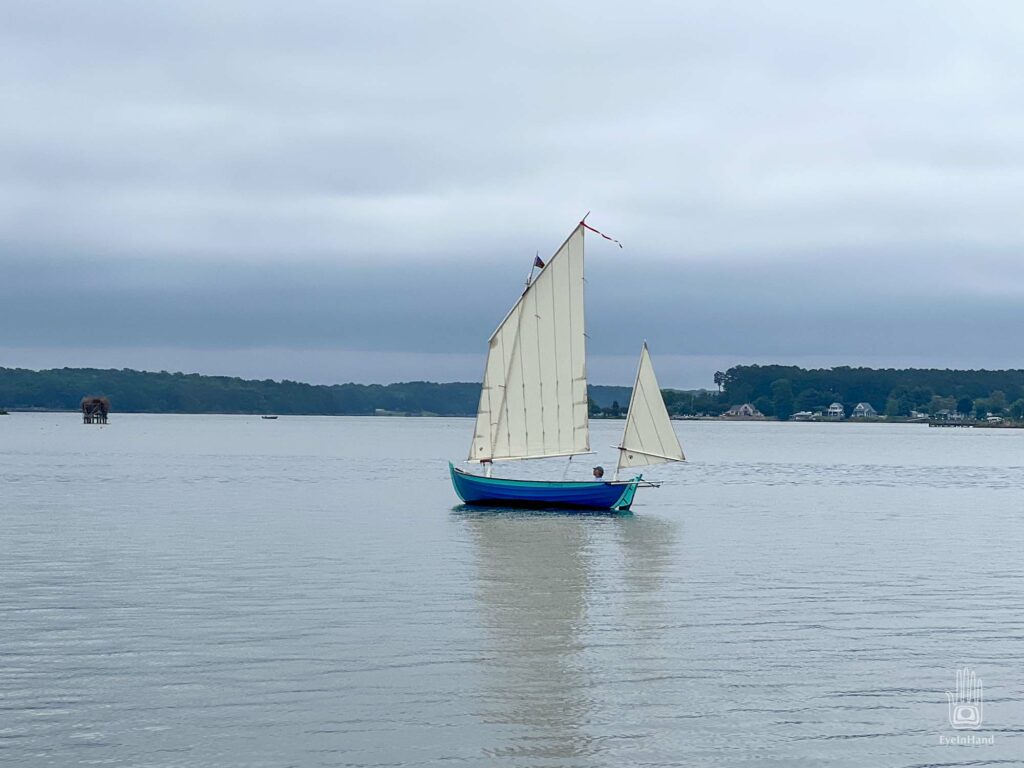

Got out for a bit, change of scenery.
Heard a poet singing to a park of children and tent homes,
from the hole where the hearse wasn’t, at a funeral home.
A nice place to watch the slow turn of celestial spheres.


Got out for a bit, change of scenery.
Heard a poet singing to a park of children and tent homes,
from the hole where the hearse wasn’t, at a funeral home.
A nice place to watch the slow turn of celestial spheres.

I pull slowly through town to the harbor. It’s almost noon, but the air is cool as I get out and start rigging. Urbanna is like Scottsville on the Rappahannock instead of the James. Nearly the same size and population, with the same small town vibe. Locals all know each other, and know who is “from away”. If you’re from away, you’re a “Come Here”. I am asked several times “Where y’all from?” – in a cheerful friendly way, truly interested to hear your stories. Inevitably this leads into long conversations, teasing out, without being too direct: “Who are your people?”, “What brought you here?”
You don’t get that as much in a big city.
There’s also the brother/sisterhood of boating that creates a quick affinity – “Lovely boat, did you built it?” – which, in the case of these small Melonseeds, leads into shared stories of small boats fondly remembered from growing up on the water.
Doug is delayed in traffic out on the interstate, which is fine because I’m always slow getting ready. I walk to the office to pay the ramp fee. In the small office the harbor master is on the radio with someone he seems to know. I make a hand motion like sliding down an incline, “You’re fine. Go ahead, I’ll come find you.” I nod and leave $20 on the desk.
He wanders out with a receipt and a boat hook as I putter with sails and line, and this exchange turns into a pleasant 20 minute conversation. He’s tall, lanky, and tan, with longish grey wind tossled hair. Wants to know all about the Melonseeds. Tells me about his cruiser up at the end of the dock. Turns out he knows Scottsville well. His niece is opening the Montessori School there, which was big news in our small town. So we cover all the bases noted above, including how this part of the Rappahannock is like coming home for me. He fills me in on some of the local news, of the latest efforts by developers to turn the town into another Virginia Beach. At the moment it’s the historic property across the harbor, Rosegill, that’s in their sites. I know some of the history of the place, both colonial and contemporary. It has changed hands and plans several times just in my lifetime. The new owners are developers with big plans that don’t have much to do with history.


Doug arrives, and in a few minutes we’re launched. It’s been a long time since we sailed in the Melonseeds; much longer for Doug since he got the Marsh Cat. And we’ve both had lots of job and house stuff to keep us away too long. So we noodle around the town harbor in Urbanna Creek a bit to be sure everything is shipshape, then head out the channel to the open River.
It’s a beautiful day, with clear skies and the first hint of fall. A cool breeze is coming out of the north at a steady 12-15mph. Perfect. The wind is against the tide, though. At this turn of the Rappahannock, there’s about 10 miles of fetch. No whitecaps, but a little lumpy in the open river. The current will reverse mid-afternoon, so we tack back and cruise along the shore. A long rock jetty protects the mouth of the harbor and today it makes a breakwater perpendicular to the wind. This leaves a half mile of flat water with good wind along shore, so we spend a couple of hours skimming back and forth, near shore and farther out, pass each other sometimes or head off in opposite directions.

This bank east of the harbor is lined by a high sandy bluff that runs for more than a mile, the whole stretch is part of the aforementioned Rosegill Plantation. Originally a grant of over 3000 acres from the King of England, it dates to 1649. A modest spread that was the summer home of the new English owner. That makes it older than Williamsburg, and only a few years later than the first settlement at Jamestown.
Of course, it was older than that. It had been home of the the Nimcock tribe. I understand their name is an Algonquin word that means, “Indians who live in towns”. They had whole villages with homes and common houses surrounded by protective palisades. They, of course, were not consulted when a King across the ocean declared it all now belonged to the latest Come Heres. The whole tribe was moved upriver.



A port was built at Urbanna Creek to ship tobacco back to Europe, duty free, the first profitable crop out of the colonies. Colonial plantations, like all those that came later, created little solar systems of economic activity, like a form of gravity that attracts more people. Before long, an older version of The Company Town emerged on the banks of the harbor. Some buildings still uphill from the harbor date to before the Revolutionary War. Beyond those, in concentric orbits, are homes and churches and other buildings constructed in each new era – before the Civil War, before World Wars I & II and beyond, up to the present day.


Rosegill remained a working plantation for most of that – through Indian Wars, Revolutionary Wars, Civil Wars, World Wars – remaining in the same family for five generations, well over two centuries. The fifth generation son and heir was an ardent Tory, vocally loyal to the King throughout the war for Independence. This did not sit well with his neighbors. He was subsequently banished to western Virginia, and the house was promptly pillaged by his Tory privateer buddies. Seems he didn’t suffer too badly, though – he only had to go as far as another family estate, his father’s 10,000 acre shooting preserve in the mountains of what is now West Virginia. He returned later, joined the new government in Williamsburg, and retained the estate until his death in the 1800s.
The property has exchanged hands many times since then. There’s an extensive collection of old photos here:
Source: Rosegill – http://www.rosegill.com/Overview/Overview.html#anchor427568
After an hour or two cruising along the brow of the bluff, the tidal current reverses and the sea settles down. We round the jetty and head northwest, reaching upriver.

A mile ahead I steer for a white sand beach in the lee of the bar at the mouth of Robinson Creek. A good place to get out and stretch. I coast to a stop among myrtle and mallow and Doug soon follows. But what looked like just sand turns out to be largely a narrow bar of old oyster shells, with a quiet tidal pond on the other side. The shells are bleached white, with all the sharp edges worn off. Likely this bar was an old midden of some kind.


This section of the Rappahannock was once lined with oyster shucking houses, on both sides of the river for miles. Another commodity that brought boom times after tobacco, Chesapeake Oysters were famous all up and down the East Coast. Those shucking and canning operations produced mountains of shell, enough to pave roads and, when there was nowhere else to put them, build land where there was none. This whole spit could have started as the place where shells were dumped back into the river. Or, before that, Native Americans also made oyster shell middens of their own. I’m speculating, but these creeks were ideal for oysters, and the deep water protected harbors ideal for shipping.

Thinking about oysters makes us hungry, and the sun is getting low. We push off for an easy broad reach all the way back. There’s just enough wind to wind into the harbor. People in sailboats, pontoon boats, and cruisers pass slowly, smile and wave. People on the beach at Bailey Point smile and wave. Very pleasant business, and a gentle glide up to the ramp in town.






As I pull slowly through town on narrow streets through neighborhoods, people I spoke with earlier in the day, out washing up their boats in the yard or tending a garden, recognize me and a wave, one shouts “Come back soon!”
We land again on Robinson Creek further up this time, pulling the boats behind us, to a working seafood wharf that’s also a rustic restaurant on stilts out over the water. Same place where Vera and John brought us on our quest for Soft Crabs back in May.
I have not eaten since breakfast. With a couple of cold beers, we each polish off a dozen local oysters, a half pound of spiced shrimp, and a Soft Crab sandwich with a side of slaw. Easily.



A fine end to a really fine day, one much needed. I think we will be back soon.


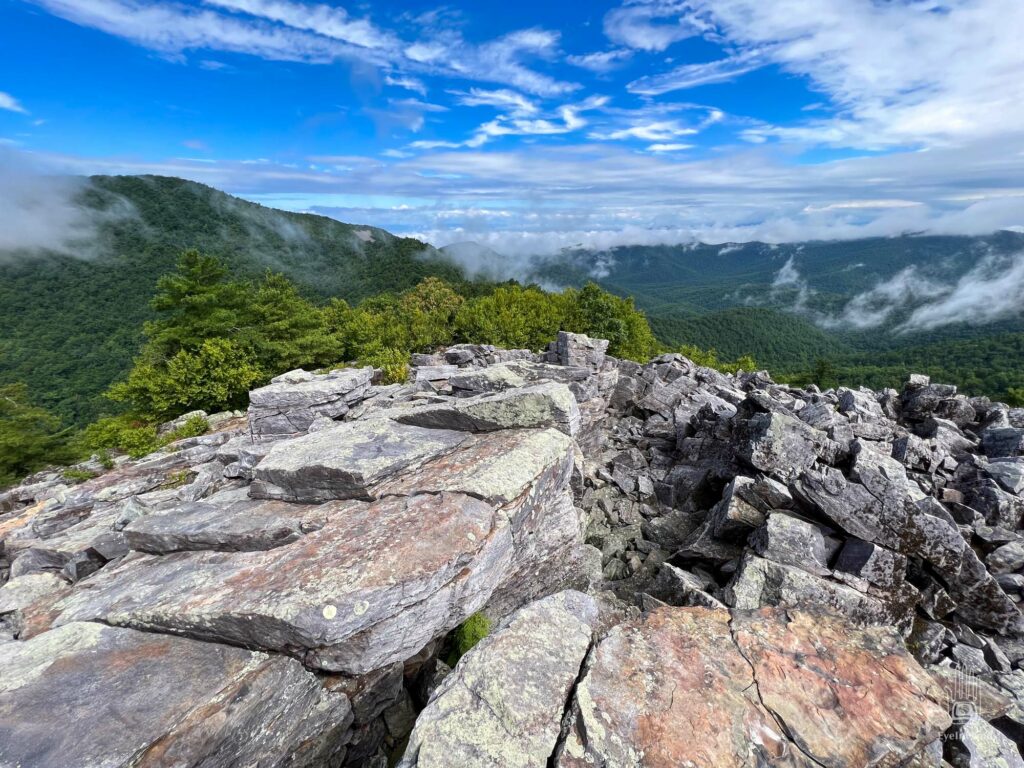
Back in college, I often drove out to the Blue Ridge to clear my head. A couple of hours on the Parkway or Skyline Drive did wonders to reset whatever was muddling my thoughts. My buddy, sometime roommate, often did the same. He was up from Guatemala for a while this summer, and we converged out in Shenandoah for a reset. He drove down with extended family from DC.
We met at Big Meadows for lunch, but before that I took a short solo hike to Black Rock Summit. We had a good two days of heavy rain after a week of sweltering heat here in Virginia, but the storm cleared out at dawn. Cleared out the air as well as my head.
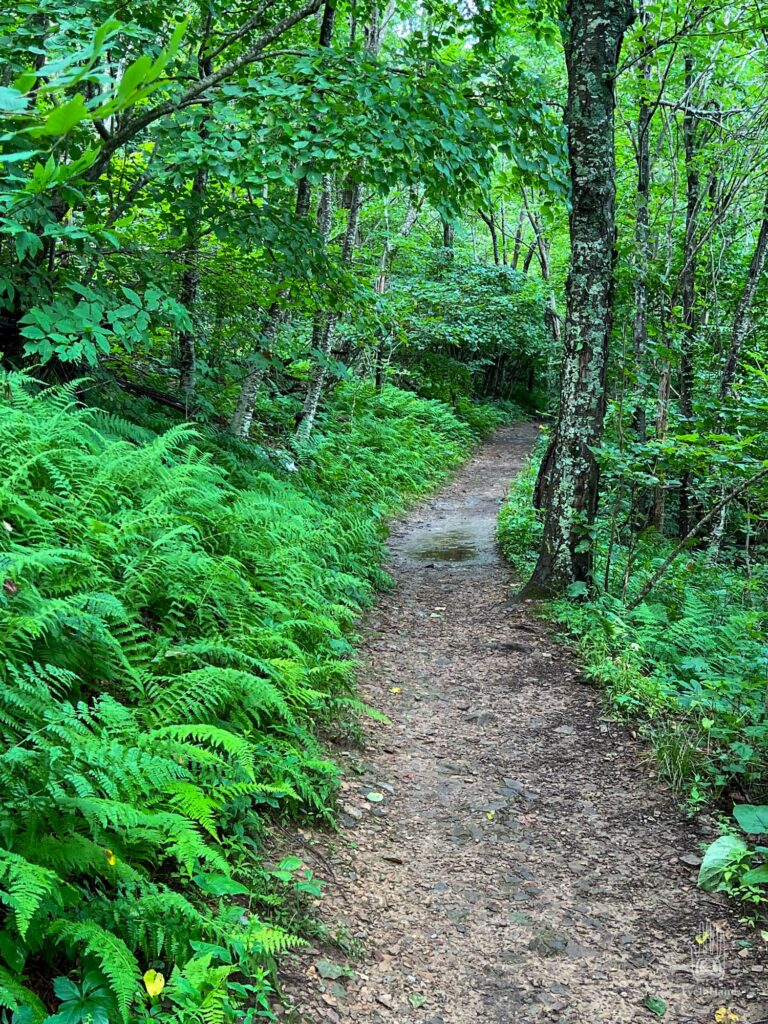
The Appalachian Trail passes through here, paralleling the ridge. It’s easy to hop on the trail for short legs. This section passes over the summit, through a rubble field of shattered rock outcroppings. In some places, threading between fractured walls of granite, smooth faces like Inca stonework.


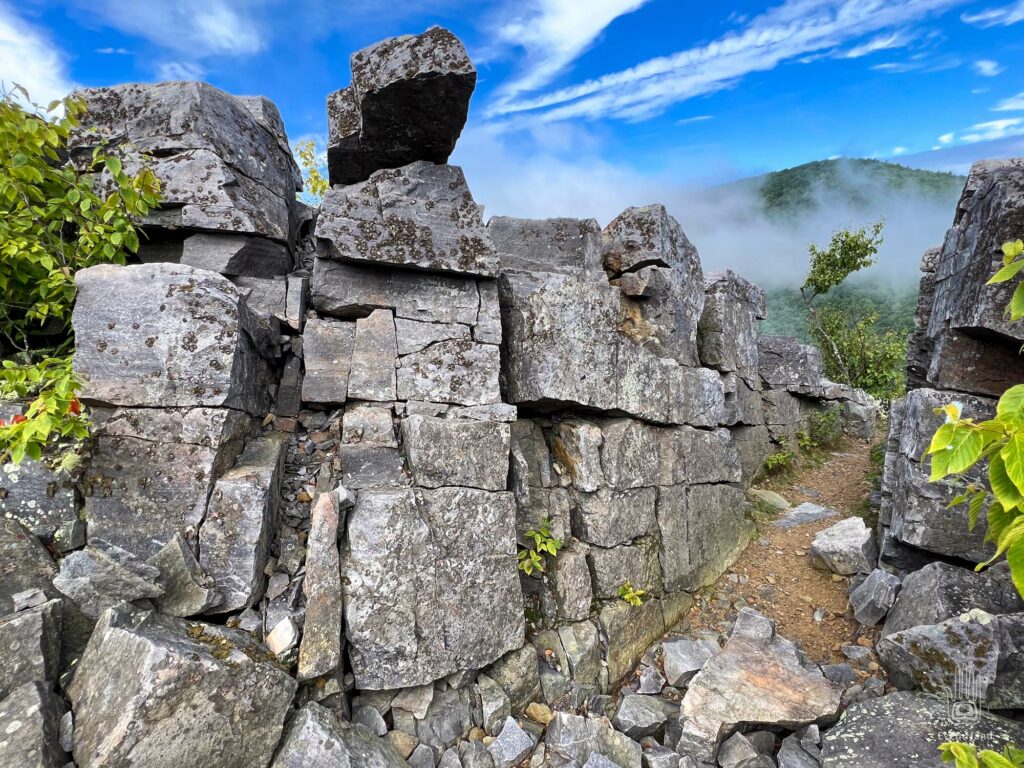
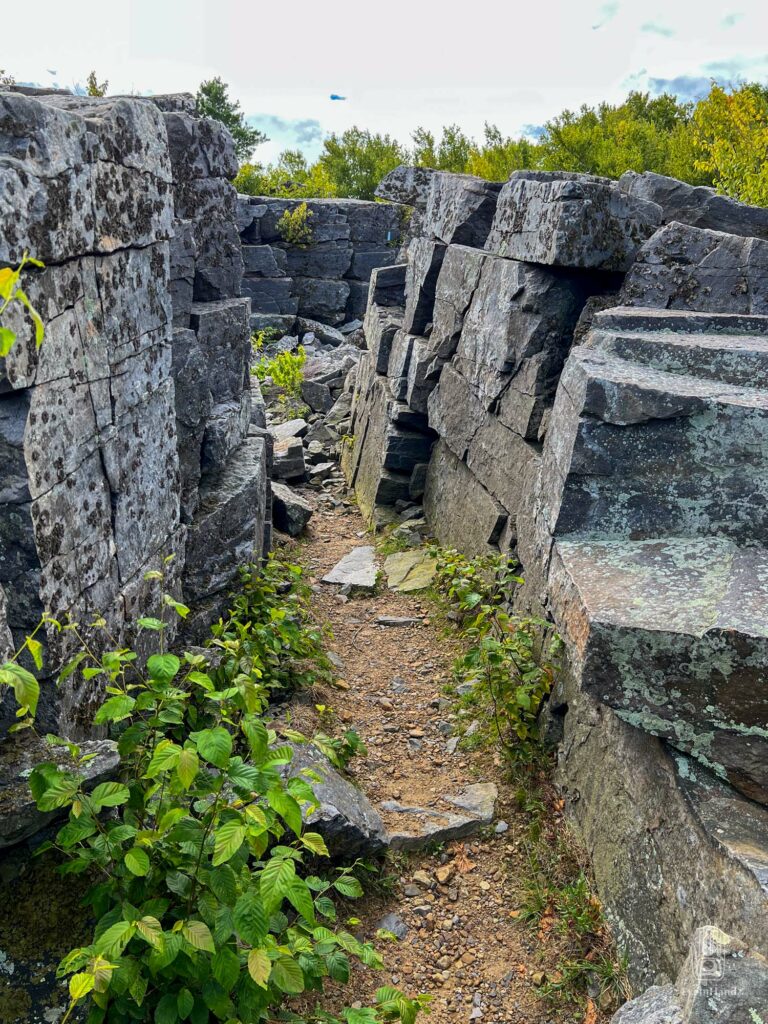
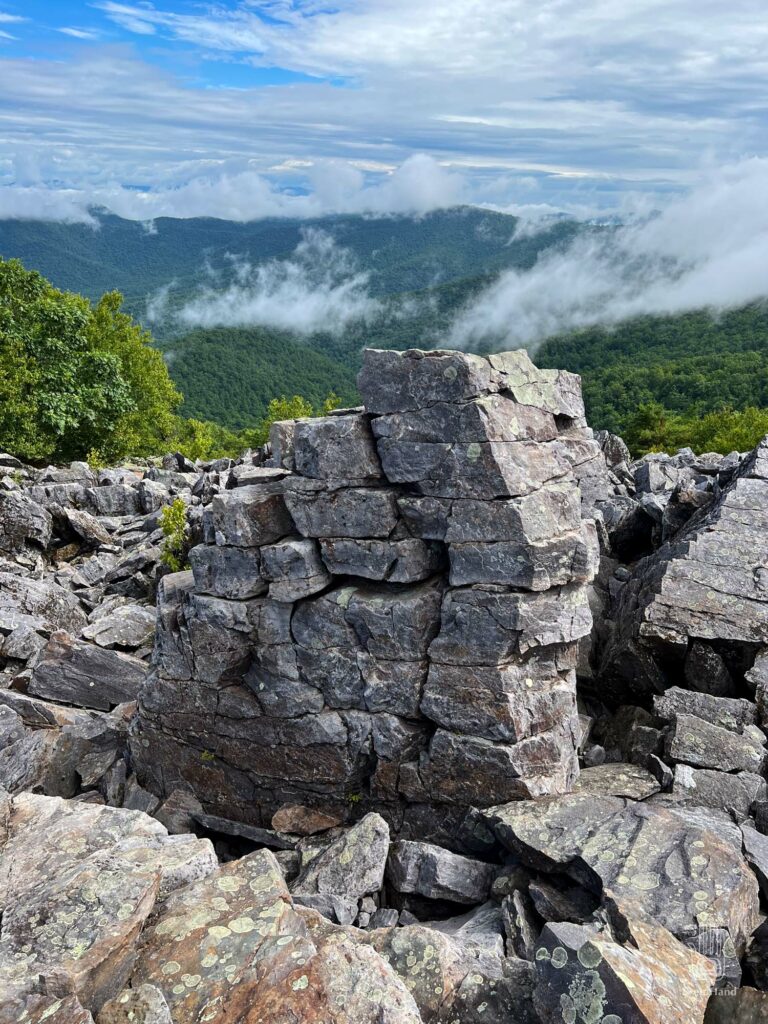
Scrambling up the blocks of stone, from the top there’s a 360 degree view. Tatters of clouds drift up the hillsides and tumble over saddles into valleys, tangle in the trees and hollers.

The lichen are vivid from the rain, and moss revives in cracks and crevices.


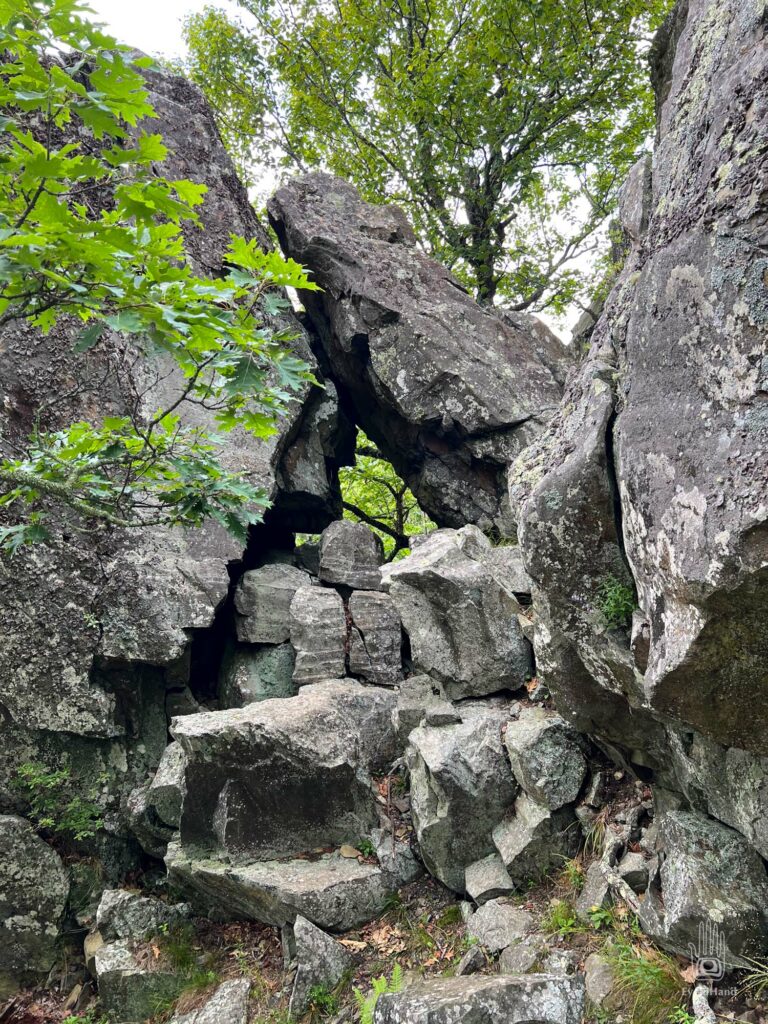

The fog and clouds cleared off for an afternoon of sunshine and light breezes. Enough for a second leisurely sail.

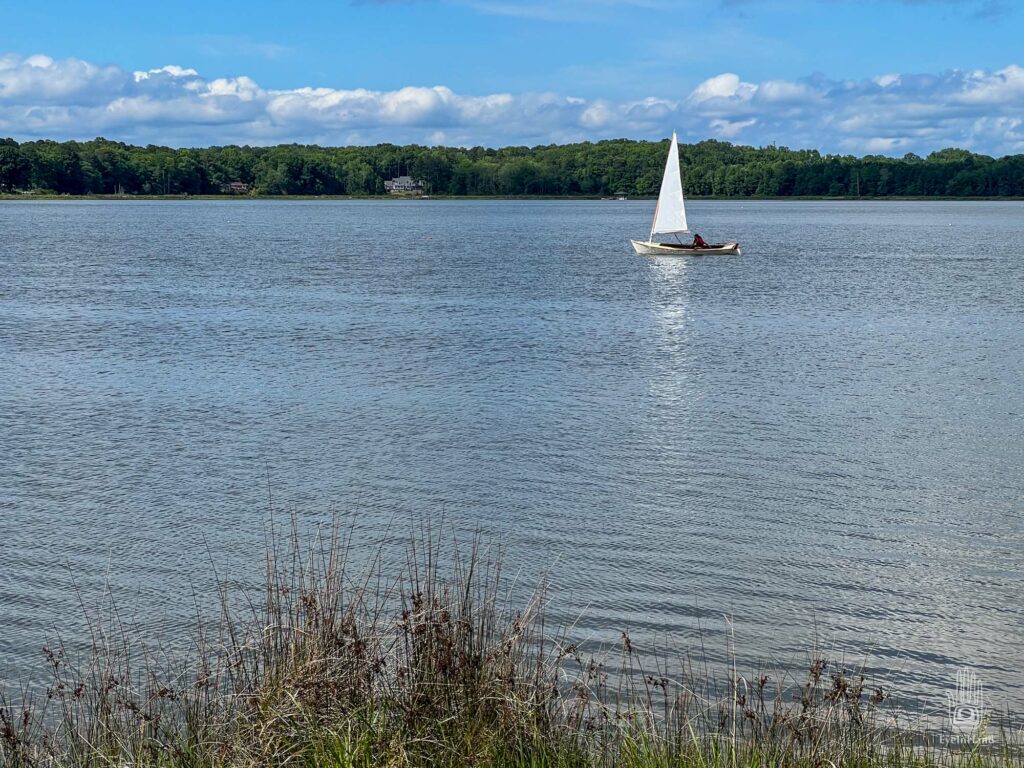
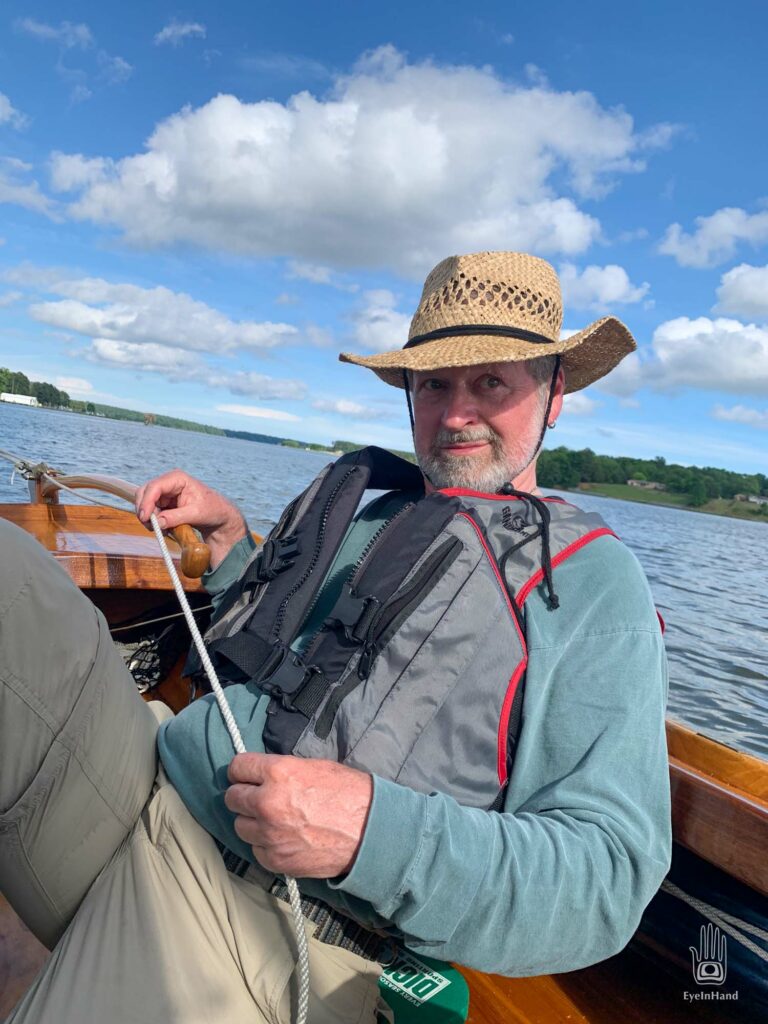

Saturday Supper is always a big pot luck. Lots of great food spread out under the sycamore trees. Dennis and I picked up four dozen local briny oysters to share, and spent most of the evening shucking and jiving and telling stories over beer, lasting past dark when the feast moved around a fire and went late into the night.





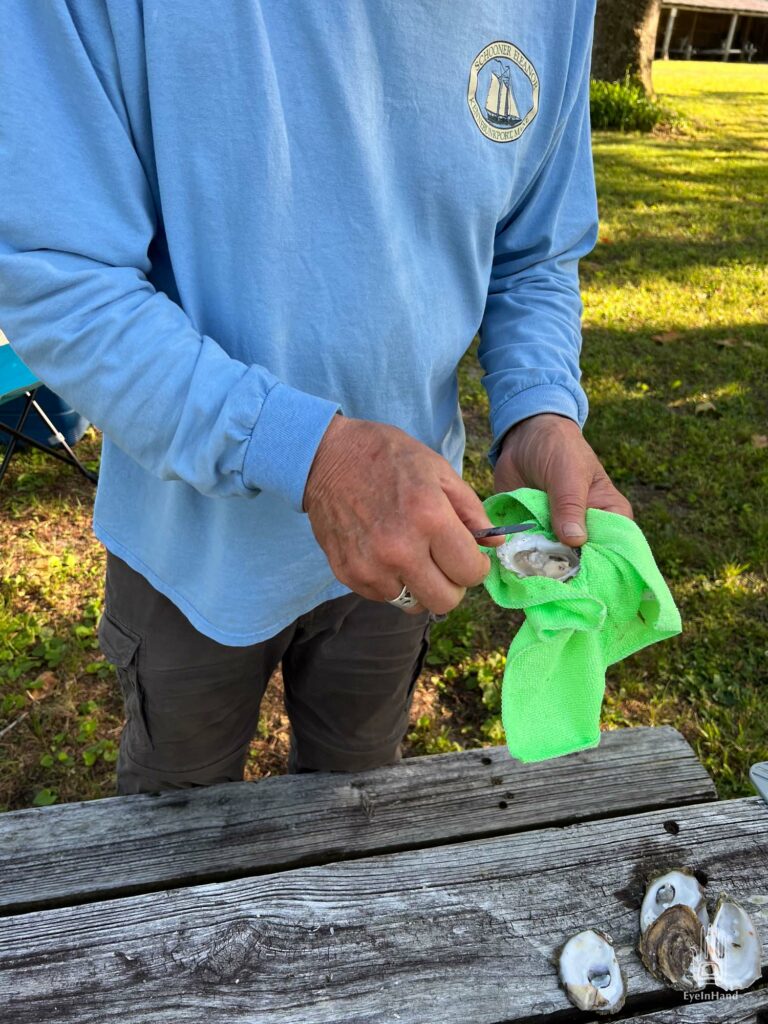



Overnight a big rainstorm came through, but was clear again by morning, and too windy to sail. Blowing hard again out of the north. Enough to dry out the tents and gear in time to pack up. Which worked up our appetites again. Vera shares my love of soft crabs and made a few calls around Urbanna. We were in luck, they were in season and we were now on a joint mission to procure a traditional Chesapeake Sunday Brunch.
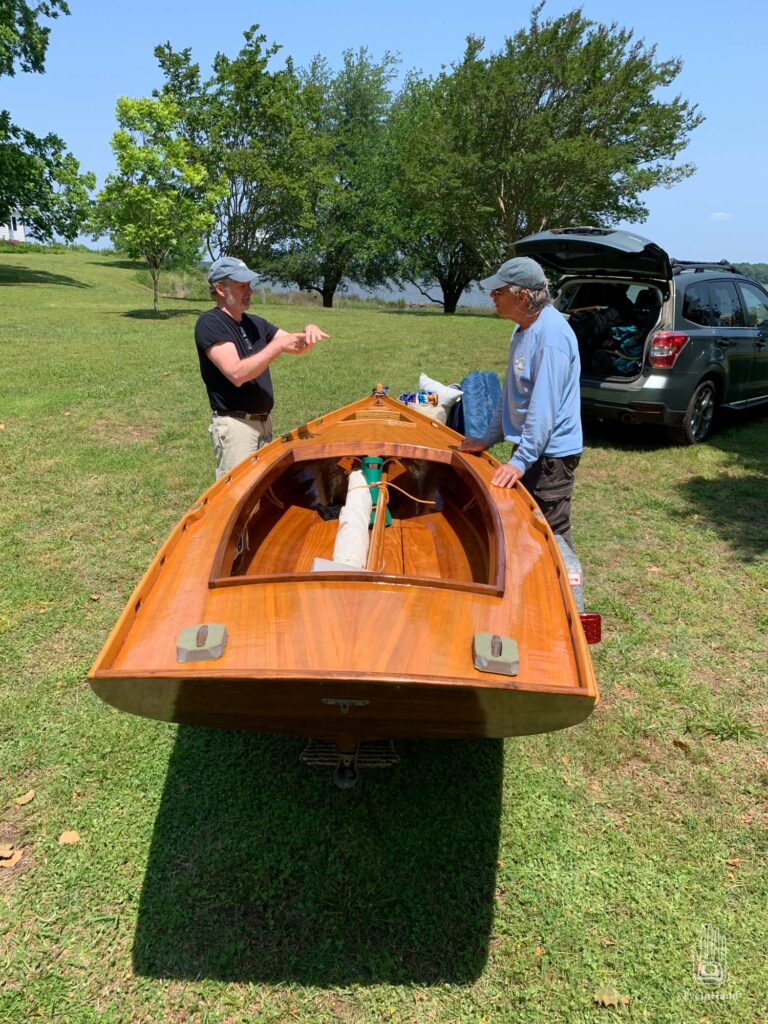
The Church Crowd beat us to our usual spot, the Virginia Cafe, and the ladies in big flowered hats snapped up the last ones. Next door was sold out, too. But local knowledge goes a long way, and soon we were off down backroads to a working seafood dock with an open air kitchen attached. Success! Fried Soft Crab Hoagies, fresh local flounder with mango chutney tacos, hush puppies, and iced tea.

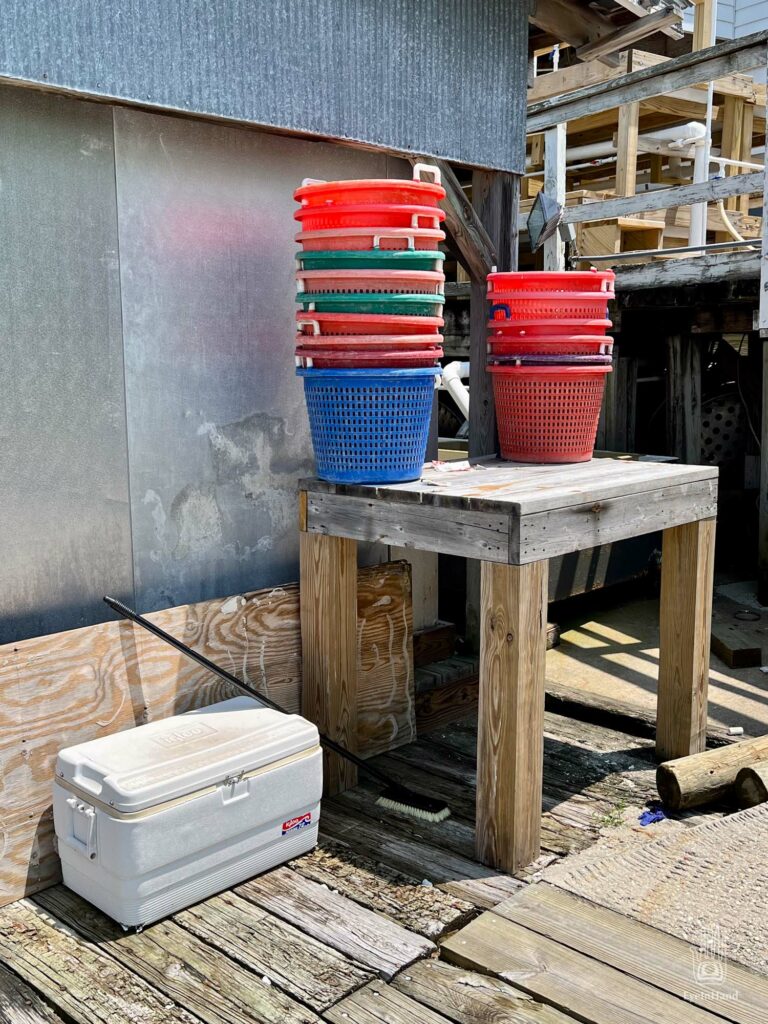
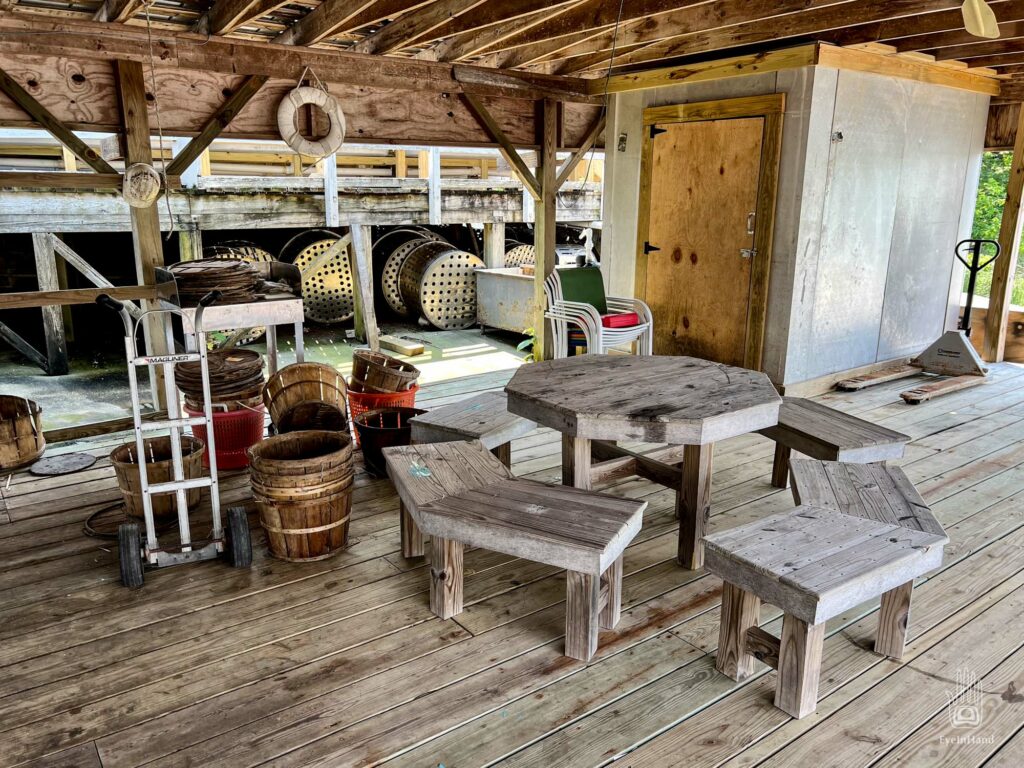


Another great trip. So glad to be back on the water again.

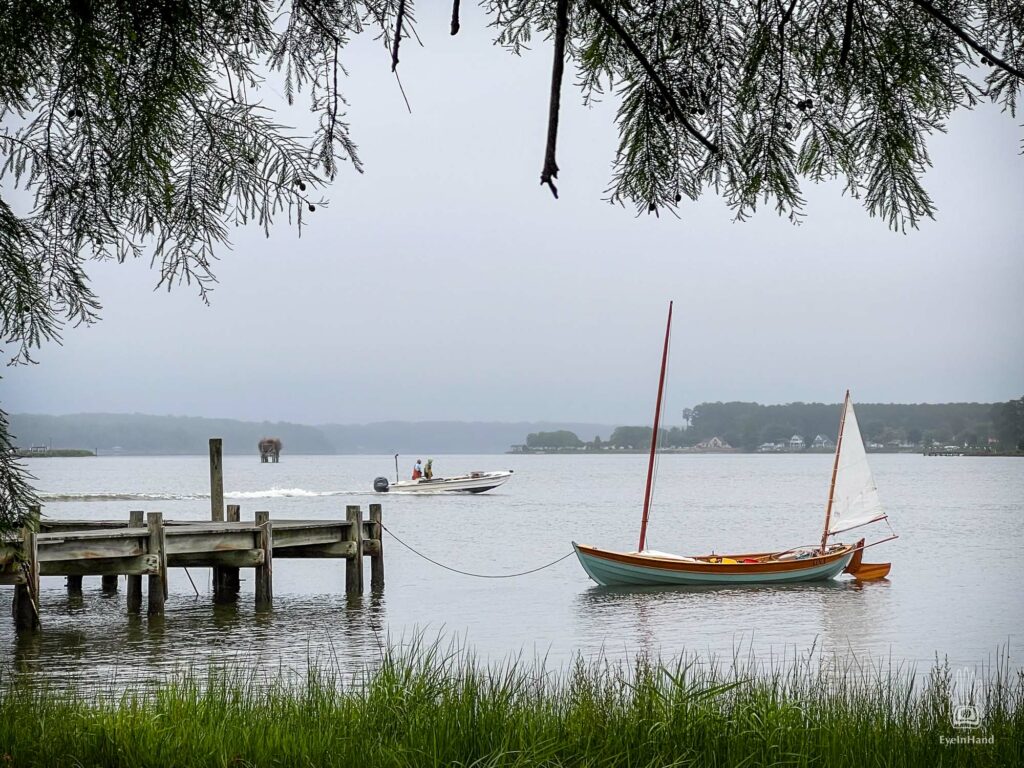
The wind blew itself out overnight. At dawn I can hear crabbers dropping pots in the water a quarter mile across the water. Big Deadrise Diesels sound like distant thunder as they fire up and head out. This far upriver, though, crabbing is done from flat bottom outboard skiffs, usually by one man working alone. I put water on for coffee and watch one work a line of pots in the fog. It’s a slow motion rodeo, a cowboy on a floating quarter horse doing slow turns around the barrels. Spin slowly around the buoy . . . pull pot – dump crabs– add bait – drop pot . . . then peel off to the next one. Repeat. Repeat. Repeat. The wake draws a line, connecting dots of buoys in the river.

A light breeze comes up, opposite direction of yesterday, and clears away the fog. Took my coffee to the docks and watched our remaining sailors creep out of the creeks and make their way in – some sailing, some rowing. Still others arrive by land with boats on trailers. The sun comes out. Soon a whole fleet of beautiful wooden boats is pulled up along the small beach.

One of the best moments of these gatherings is to see up close the boats you know already only from photos and videos. And their owner/builders, too. Jim Luton and Holly Sears moved down from Brooklyn a couple years ago. Holly has connected with one of the oldest sailing clubs on the Bay, and teaches sailing classes there. Didn’t take long for Jim find his way to the boat shop at the Deltaville Museum. Now he and John England and museum volunteers build deadrise power skiffs, a traditional style of wooden boat native to this region.

From photos, though, I only knew about the sailboats he built in his shop in Brooklyn. First was a sharpie skiff called Cricket, with a leg o’mutton rig and the classic lines of Chesapeake and Carolina Crabbing Skiffs. Next was the more challenging Matinicus Peapod – all lapstraked and round bottomed, pointy on both ends – designed for the lobster fishery of Matinicus Island in Maine. And here they both were, more beautiful in person than pictures.


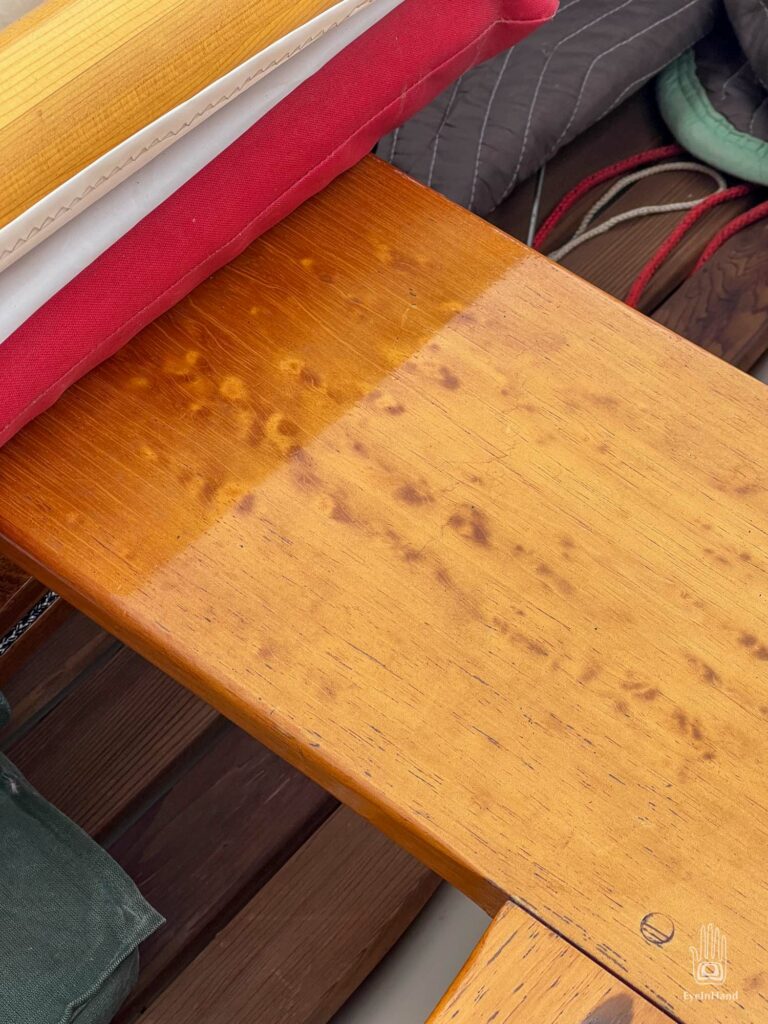

Holly rigs the Matinicus Peapod built by Jim Luton.
There are also new boats to me: Greg Taylor’s recently completed Tom Cat, which he turned up to 11 on the detailing, and Rob Kunzig’s Ilur.


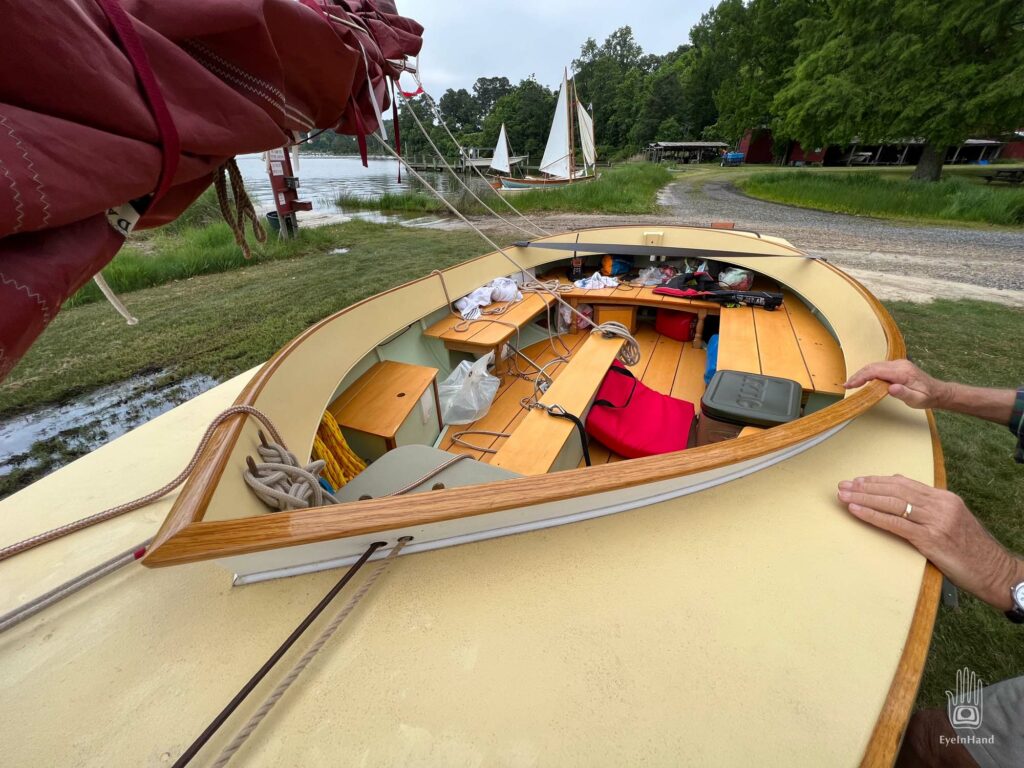



Greg Taylor’s Tom Cat
And there are familiar boats not seen since pre-pandemic times. John and Vera’s traditional skiff I know from here and St. Michaels. Dennis Keener’s Caledonia Yawl has fresh paint and a new color scheme, Eddie Breeden’s always fast Sooty Tern, Harris Bucklin’s Caledonia, and Jim Arthur’s Coquina, a fast boat that sails like a wet witch.





Most of the guys who started days ago were beat up pretty well by the wind, had enough and pulled out. The rest of us late comers all set out for a leisurely sail in the Piankatank.
My first saltwater outing in five years was a bumpy re-entry. T and I rigged and shoved off fine, but Aeon’s rudder caught on submerged riprap off the beach by the ramp. By the time we wiggled free we were no longer pointing to open water. Instead, got swung round aiming directly at the dock, and the boats tied to it. I bumped everything possible between the shore and the river – docks, and boats – not hard, but much to our mortification. Everyone was on the dock for the show, of course. Which is just as well – they grabbed lines and fended us off with no visible scars, mine or theirs. And Vera made us all pause mid-bumble to capture the moment.
Smile! 🙂

Everything got instantly better away from shore.





